| 1 | Found in 16 countries |
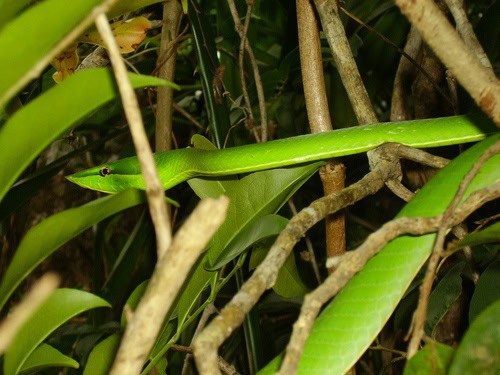
The green vine snake is a mildly venomous species of the Americas, which reaches a maximum of 2 metres and is typically 150cm. This snake gets its name from its obvious resemblance to a dangling piece of rainforest foliage, and is a strange visual parallel of the Asian vine snake living in Thailand, to which it has no relation.
Boa constrictors are far more famous, and rattlesnakes more feared. Yet green vine snakes are secretly one of the western hemisphere’s most common snakes, inhabiting a giant empire, although it’s actually more of a vast disorganised territory and not one with an emperor green vine snake at the head. Their many countries include…
Central America – Guatemala, Honduras, El Salvador, Belize, Nicaragua, Costa Rica, Panama (7/7).
South America – Colombia, Venezuela, Ecuador, Brazil, Guyana, French Guiana, Suriname, Peru, Bolivia.
Green vine snakes also inhabit the far south of Mexico, though they fall well short of Mexico City. They’re mainly a rainforest species, yet they aren’t completely inflexible, and sometimes appear on roads and in clearings directly adjacent to forests.
Likewise, green vines snakes are a heavy branch dweller, but also stray regularly to the ground in order to conduct foraging expeditions. It’s this flexibility which has helped them to take over such a vast swathe of the Americas.
| 2 | Uses fear to stay alive |
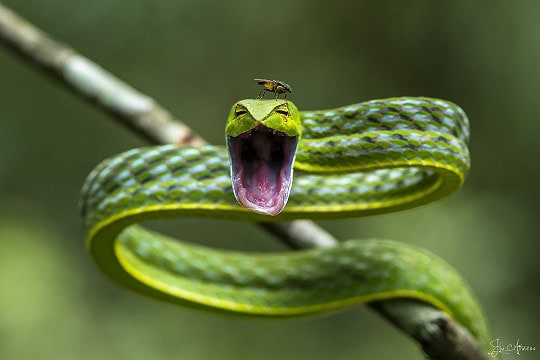
Green vine snakes have one of the most over the top defensive displays in comparison to how deadly they really are, as they act like a total maniac to convince explorers to back off.
First the danger threshold must be breached. Oxybelis fulgidus must feel it is in mortal peril to risk disrupting its carefully planned ambush posture. Whether it’s really in danger doesn’t matter, it’s all about what the snake’s paranoid mind perceives. The green vine snake throws the upper 1/2 of its body into the air, which it coils into a sharp S-shape. It flattens its head to create an illusion of size, and opens it mouth freakishly wide, to convey extreme danger to its enemies (see above).
Oxybelis fulgidus has a particularly huge mouth to make this possible, covering almost the entire length of their head. Imagine if your own mouth spread all the way to the corners of your jaw, and you’d get the idea.
| 3 | Freezes solid to avoid detection |
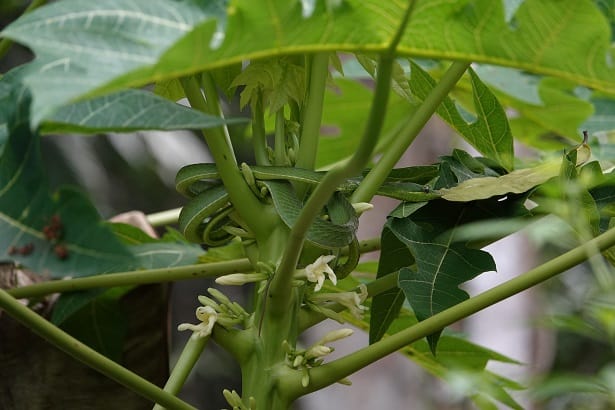
Another weird trick is to fully extend its tongue, hold it rigidly in place, and press the two forked tips tightly together. By contrast, Oxybelis fulgidus doesn’t look intimidating at all when waiting patiently in ambush. They look mild-mannered, even considerate.
Oxybelis fulgidus has a slight downside compared to the brown vine snake, its cousin. The latter also bares its mouth incredibly widely, but has a shocking velvet black mouth lining, which cause birds to panic, while in green vine snakes it’s merely bluish-pink.
Green vine snakes are experts at freezing completely, ceasing all movement like the flick of a switch. Compared to an emerald tree boa, they’re less strict about ambush. They often use a hybrid strategy – waiting for lizards to pass their ambush perch, then pursuing them for a few minutes to get within striking range. They do this exceedingly carefully – moving only when the lizard moves, stopping dead when the lizard gets suspicious and stops.
| 4 | Diet: reptiles and birds |
A 2009 study analysed the green vine snake’s diet, combining data from old museum specimens taken from northern Brazil, and any historical reports they could dig up.
The verdict was a diet of 53.7% lizards, at 27 prey recorded. Within this, the favourite was easily iguanas, at 15 prey recorded. Birds were the green vine snake’s second favourite prey class, at 46.3% of prey recorded (25). Not one mammal was found among the 54 prey included, even though they’ve been fed them successfully in captivity. While green vine snakes can eat rodents, they’re clearly last on their list for taste bud sensation.
No fellow snakes were recorded as prey either. The top recorded individual prey was simply “unidentified bird”, at 9 cases, probably because a jumbled mass of beaks and feathers were found inside. The favourite individual prey included…
Ameiva ameiva (3) – the giant ameiva. Also confirmed prey for Amazon tree boas and Neuwied’s false boas.
Yucatán spiny lizard (3) – also confirmed prey for salmon bellied-racers and Central American tree snakes.
Anolis chrysolepis (2) – the goldenscale anole. Also confirmed prey for blunt-headed tree snakes and Amazon flat snakes.
| 5 | Mimics a swaying vine |
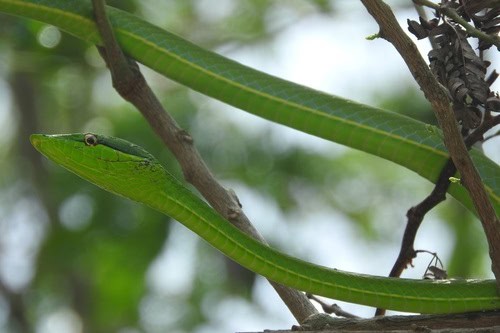
To a bird, the green vine snake must be an absolute nightmare. Its strategy is wait patiently until its prey is directly below, then drop down from its branch in mere milliseconds and bite them by the head. It’s like a vine coming to life and revealing hidden fangs, which spew a rainforest poison. Their disguise is so excellent that they could be anywhere.
Oxybelis fulgidus is consistent in its hunting techniques in that they always go for the head or neck. The green vine snake then lifts its prey 20-40cm off the ground, to prevent a sudden burst for freedom using its strength. The green vine snake waits patiently while its rear-fanged venom soaks in, which must slowly penetrate open wounds. Once the prey is dead, the green vine snake swallows it by the head.
Gren vine snakes are mainly ambush predators, waiting for hours for lizards to obliviously stray within striking range. Most of us impatient humans would give up after a few minutes, yet a Colombian or Costa Rican rainforest is so swarming with life that Oxybelis fulgidus knows that an anole will come wandering eventually.
But the main reason for their success is their colour choice. If all green vine snakes switched to blue overnight, the species would probably be extinct within decades, or vastly reduced in number. They specifically choose areas of thick jungle vegetation to hunt in, normally lower areas 1-2 metres above ground, to cloak themselves in endless greenery. Once they’ve swallowed a meal, they can retreat into the depths of this greenness to peacefully digest.
| 6 | Brazilian tales |
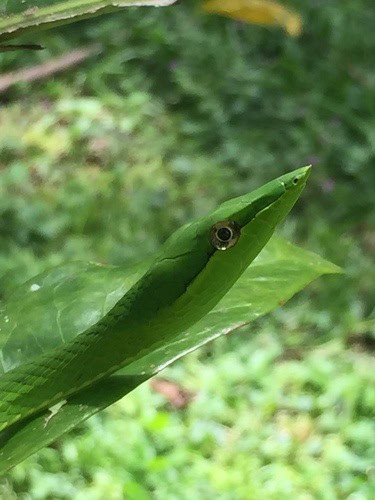
Green vine snakes have their fair share of failures as well as successes. In one tale from Brazil’s Manaus state, a juvenile green vine snake came across two giant ameivas fighting each other. The snake sensed an opportunity, and lunged at both, but wasn’t accurate enough and missed.
One ameiva soon returned to confront the snake, but the green vine snake used its camouflage skills and froze solid. While hunting, it had carefully remained in the margins of the forest, and never entered the adjacent clearing. The snake was invisible, causing the frustrated ameiva to give up and leave. The green vine snake then moved to a new position 6 metres away, where it found a striped forest whiptail resting on a log. The green vine snake approached, but the whiptail immediately noticed its predator and flew into an aggressive rage. Before the hesitant green vine snake could lunge, the whiptail had fled.
Apparently, this species needs time to hone its skills. However, the green vine snake did capture three giant ameivas over the day, which also shows that they can swallow multiple meals.
| 7 | ID signs to remember |
At a distance, the body of Oxybelis fulgidus has no colour other than green. It’s a sea of forest vine disguise. Their face is split into two clear shades at the eye, darker green above and paler green below, and this is a great ID sign to remember.
From a side view, their snout is exceptionally pointed, and unlike tree-dwelling vipers such as eyelash vipers or Bothrops bilineatus, their pupils are round rather than vertical.
This is a freakishly thin snake, no wider than 2cm at its mid-section. As these and these images show, blue green vine snakes can occasionally be found on Central American forest floors. But the snakes shown above are dead, so rather than freaky morphs, it’s more likely that Oxybelis fulgidus is actually green due to a mixture of yellow and blue pigments, and that the yellow pigments break down faster immediately after death. This is what happens with the USA’s smooth green snake, which infamously turns blue post death.
| 8 | Targeted venom against reptiles |
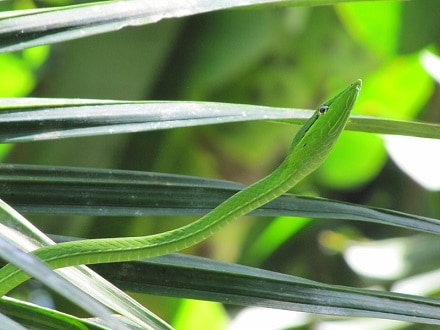
In 2013, a unique neurotoxin was discovered in green vine snake venom, dubbed fulgimotoxin. This was a three-finger toxin, which was highly neurotoxic to lizards and birds, yet had little affect on mice. The mice showed no signs of distress or incapacitation, let alone death. Oxybelis fulgidus has a highly specialised venom.
At 32%, fulgimotoxin made up a huge portion of the crude venom, allowing just small quantities to take down their prey. Fulgimotoxin is so rare that even its fellow family member the brown vine snake lacks it.
Meanwhile, a 2021 study found that the venom was in fact toxic to mice, but only moderately, and was “nearly an order of magnitude” more toxic to reptiles. It was also weak against non-native Hemidactylus geckos, showing that its venom is intelligently tailored to local species. What about humans, seeing as we’re mammals like mice? Bites from green vine snakes are incredibly rare, taking up no space in South America’s snakebite statistics.
| 9 | Human bites are mostly mild |
The first ever case in the wild happened in June 2017, in the Brazilian Amazon. A 67 year old man was holding and pruning a tree when a thin green snake attached itself to his left arm. Feeling its fangs sink in, the man didn’t delay, and ripped the snake off instantly with his other hand. Still, he felt the rapid onset of dizziness and an elevated heartbeat. Swelling, redness, and ecchymosis soon manifested around the bite site, but rapidly faded. This is a mysterious case – the dizziness and elevated heatbeat could have been neurotoxic effects, yet they could have simply been from the man panicking.
Their close relative the brown vine snake has unleashed slightly more mayhem. One author was bitten on the thumb and middle finger, and suffered moderate swelling that lasted for 2 days. Another experienced slight swelling, itching and a large blister near the deepest fang puncture. This gives us clues about the green vine snake, but at worst, this species will only cause minor discomfort for a couple of days.
| 10 | Vine snake lookalikes |
The Oxybelis vine snake genus has 11 members, not all of which overlap. Like the green vine snake, many have been spotted dangling from branches, kinking their body strangely, swaying in the breeze in order to mimic foliage, which is only possible because of their extremely thin bodies.
The most northerly member is the thornscrub vine snake (Oxybelis microphthalmus), which mostly inhabits Mexico, and just crosses the border into Arizona near Tucson. The brown vine snake reaches furthest south, and is the second most common after the green.
The greatest lookalike is probably Cope’s vine snake (Oxybelis brevirostris), which overlaps the green vine snake in a large chunk of its range, including Panama and Columbia. At first glance the two are similar, but green vine snakes have a far longer head, while O. brevirostris has a blunted head. Green vine snakes also have a narrow, pale line bordering their belly, and a longer body length overall. Outside their own genus, Oxybelis members are most closely related to parrot snakes (Leptophis).
